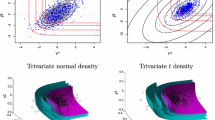Abstract
The Black–Litterman and related approaches modify the return distribution of a normally distributed market according to views or stress-test scenarios. We discuss how to broaden the range of applications of these approaches significantly by letting them act on the risk factors underlying the market, instead of the returns of the securities. Code implementing the models discussed here can be found at www.symmys.com>Teaching>MATLAB.


Similar content being viewed by others
References
Black, F. and Litterman, R. (1990) Asset allocation: Combining investors' views with market equilibrium. Goldman Sachs Fixed Income Research.
Cheung, W. (2007) The Black–Litterman Model: Augmented for Factor-based Portfolio Construction. Lehman Brothers Publications.
Malz, A. M. (1997) Option-implied Probability Distributions and Currency Excess Returns. Federal Reserve Bank of New York Staff Reports.
Meucci, A. (2005) Risk and Asset Allocation, Springer.
Meucci, A. (2008) The Black Litterman approach: Original model and extensions. Encyclopedia of Quantitative Finance, Extended version available at symmys.com>research>Working Papers%3Eresearch%3EWorkingPapers.
Meucci, A. (2009) Normal and elliptical simulations with exact mean and covariance. Working paper available at ssm.com.
Mina, J. and Xiao, J. Y. (2001) Return to RiskMetrics: The evolution of a Standard. RiskMetrics Publications.
Qian, E. and Gorman, S. (2001) Conditional distribution in portfolio theory. Financial Analyst Journal 57: 44–51.
Acknowledgements
I gratefully acknowledge the helpful feedback from Bob Litterman.
Author information
Authors and Affiliations
Corresponding author
Additional information
1leads the research effort of the portfolio analytics group at Bloomberg L.P. Concurrently he is Adjunct Professor at the graduate programme in Mathematical Finance of the Courant Institute – NYU. Previously, Attilio was a researcher at Lehman Brothers, a trader at the hedge fund Relative Value International, and a consultant at Bain & Co. He is the author of Risk and Asset Allocation – Springer and several other publications. He teaches for charity graduate courses on quantitative risk- and portfolio-management worldwide and he is frequently invited as a speaker to conferences, financial institutions and universities. He holds a BA summa cum laude in Physics from the University of Milan, an MA in Economics from Bocconi University, a PhD in Mathematics from the University of Milan and he is CFA chartholder. He is fluent in six languages and loves physical activity in the outdoors.
APPENDIX A
APPENDIX A
Estimation/Calibration of the Reference Model
In general, the prior market model f X is determined by a combination of econometric estimation and ad-hoc market-implied parameterisation. To imply the parameters, first a parametric model f X θ is chosen for the prior, where θ is a vector of parameters that fully determine the distribution of X. The dimension of θ can be very large, as this framework also includes non-parametric approaches.
Next, by time series analysis, some parameters are estimated, and θ is thereby bound to a given subspace Θ.
Other parameters in θ are then implied from a preferred reference book w̃, which can be a benchmark in standard asset management or a general-equilibrium portfolio as in BL or the current book in a trading environment. The parameters are implied as follows:

where L is a non-negative loss such as the norm

and S and C are defined in (14).
Finally, in case (A.1), has multiple solutions, then  can be picked by symmetry principles such as entropy maximisation.
can be picked by symmetry principles such as entropy maximisation.
Once all the parameters are determined, the reference model is set as 
For instance, consider the normal assumption

The parameters θ are in this case the expectation μ and the covariance Σ. To determine these parameters, first we specialise (14) by choosing an index of satisfaction. Here we choose the classical mean-variance trade-off. For alternative specifications such as mean-VaR, mean-CVaR, certainty-equivalent or spectral measures, see Meucci (2005). Accordingly, the book w* is optimal if it satisfies

In this expression, E(μ, Σ) is the vector of the expectations of the p&1 of each security in the book, fully determined by (A.3) through the securities pricing functions Pt+τ=P(X, I t ); S(μ, Σ) is the covariance matrix of the p&1 of all securities; δ is a risk-aversion coefficient and B, b̄ and b̄ determine a set of linear constraints.
We then estimate the covariance Σ̂ from time series analysis of the market X. Next, we compute the implied expected values μ̂, defined in such a way that

where w̃ is preferred as a benchmark, or a general-equilibrium portfolio, or the current book. If the number of parameters in μ̂ exceeds those in w̃, as is often the case, we pin down some values in μ̂ based on historical estimates. This is (A.1) in the current context. More in general, we might impose structure on the covariance and imply terms in the covariance as well.
Rights and permissions
About this article
Cite this article
Meucci, A. Enhancing the Black–Litterman and related approaches: Views and stress-test on risk factors. J Asset Manag 10, 89–96 (2009). https://doi.org/10.1057/jam.2008.42
Received:
Revised:
Published:
Issue Date:
DOI: https://doi.org/10.1057/jam.2008.42




